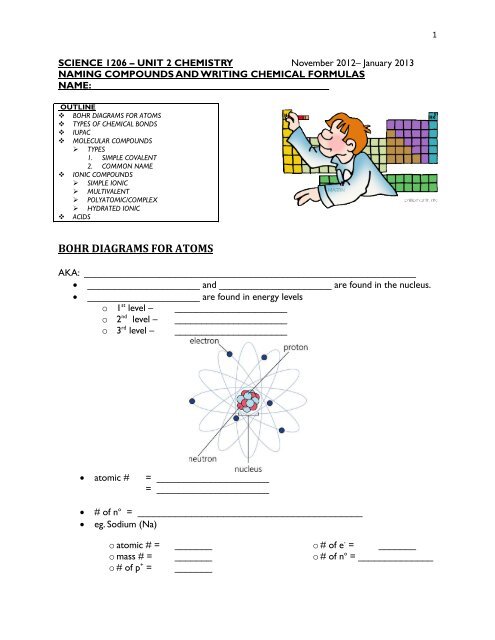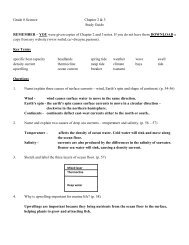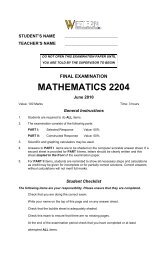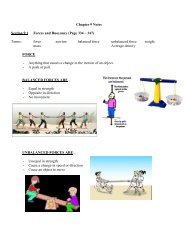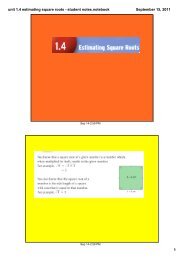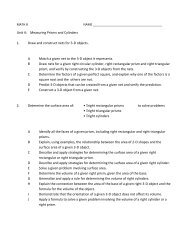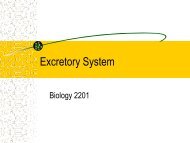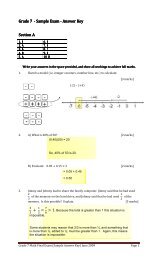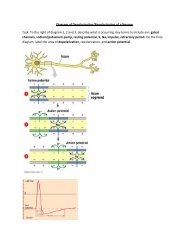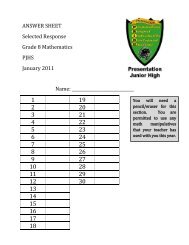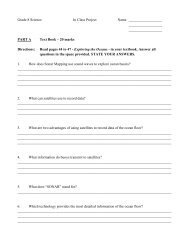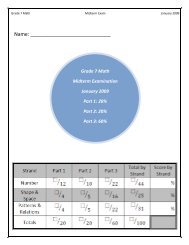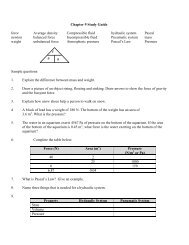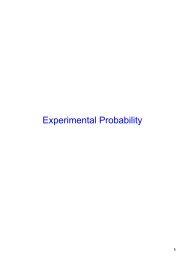Create successful ePaper yourself
Turn your PDF publications into a flip-book with our unique Google optimized e-Paper software.
1<br />
SCIENCE 1206 – UNIT 2 CHEMISTRY November 2012– January 2013<br />
NAMING COMPOUNDS AND WRITING CHEMICAL <strong>FOR</strong>MULAS<br />
NAME:_________________________________________________<br />
OUTLINE<br />
<strong>BOHR</strong> <strong>DIAGRAMS</strong> <strong>FOR</strong> <strong>ATOMS</strong><br />
TYPES OF CHEMICAL BONDS<br />
IUPAC<br />
MOLECULAR COMPOUNDS<br />
‣ TYPES<br />
1. SIMPLE COVALENT<br />
2. COMMON NAME<br />
IONIC COMPOUNDS<br />
‣ SIMPLE IONIC<br />
‣ MULTIVALENT<br />
‣ POLYATOMIC/COMPLEX<br />
‣ HYDRATED IONIC<br />
ACIDS<br />
<strong>BOHR</strong> <strong>DIAGRAMS</strong> <strong>FOR</strong> <strong>ATOMS</strong><br />
AKA: ______________________________________________________________<br />
_____________________ and _____________________ are found in the nucleus.<br />
_____________________ are found in energy levels<br />
o 1 st level – _____________________<br />
o 2 nd level – _____________________<br />
o 3 rd level – _____________________<br />
atomic # = _____________________<br />
= _____________________<br />
# of n o = __________________________________________<br />
eg. Sodium (Na)<br />
o atomic # =<br />
o mass # =<br />
o # of p + =<br />
_______<br />
_______<br />
_______<br />
o # of e - = _______<br />
o # of n o = ______________
2<br />
VALENCE LEVEL<br />
_________________________________________________________________<br />
Electrons in this level are called _________________________________________<br />
To become more stable, atoms _______________________________ electrons such<br />
that their valence level has the maximum number of electrons.<br />
(ie. they have the electron structure of the nearest inert noble gas.)<br />
Example:<br />
Draw a Bohr diagram for a Li atom:<br />
Example:<br />
Draw a Bohr diagram for a Ne atom:<br />
Example:<br />
Draw a Bohr diagram for a S atom:<br />
Which Bohr diagram above is drawn incorrectly?
3<br />
TYPES OF CHEMICAL BONDS<br />
A CHEMICAL BOND is a ____________________________________________.<br />
<br />
2 TYPES of Chemical bonds<br />
o __________________________________<br />
o __________________________________<br />
COVALENT BOND<br />
IONIC BOND<br />
<br />
<br />
<br />
<br />
<br />
<br />
<br />
<br />
<br />
<br />
A COVALENT BOND _______________________________________________.<br />
AKA: _______________________________<br />
Occurs between ___________________________________________________.<br />
Solutions of covalently bonded substances are ______________________________.<br />
An IONIC BOND is _________________________________________________<br />
_______________________________.<br />
Usually between ____________________________________________________.<br />
Solutions of ionic bonded substances are __________________________________.<br />
______________________________ consist of atoms or ions of two or more<br />
elements bonded together.<br />
ELECTROLYTES<br />
◦ A solution that _______________________________________________.<br />
◦ General Examples: _____________________________________________<br />
◦ Specific Examples: _____________________________________________<br />
___________________________________________________________<br />
NON-ELECTROLYTES<br />
◦ A solution that _______________________________________________.<br />
◦ General Examples: _____________________________________________<br />
◦ Specific Examples: _____________________________________________
4<br />
IUPAC<br />
<br />
<br />
<br />
________________________________________________________________________<br />
A global organization that _____________________________________________.<br />
One job of the IUPAC is to give compounds _______________________________.<br />
MOLECULAR ELEMENTS<br />
There are 7 elements that are ___________________________, in their natural<br />
state.<br />
___________<br />
___________<br />
___________<br />
___________<br />
___________<br />
___________<br />
___________<br />
Other molecular elements: ___________ ___________<br />
Memory tool: _________________________________<br />
MOLECULAR COMPOUNDS<br />
Composed of ______________________________________________________.<br />
2 TYPES:<br />
o _______________________________________________<br />
o _______________________________________________<br />
BINARY MOLECULAR COMPOUNDS<br />
AKA: ______________________________________________________.<br />
Composed of two types of elements (binary)<br />
Binary Molecular Compounds use IUPAC prefixes to indicate the number of each atom<br />
present:<br />
1 6<br />
2 7<br />
3 8<br />
4 9<br />
5 10
5<br />
Writing the Name from the Molecular Formula<br />
RULES:<br />
1. ________________________________________________________________.<br />
2. ________________________________________________________________.<br />
3. ________________________________________________________________.<br />
examples<br />
o N2O4<br />
o P2O5<br />
o CCl4<br />
o SO3<br />
________________________<br />
________________________<br />
________________________<br />
________________________<br />
Writing the Molecular Formula from the Name<br />
RULES:<br />
1. ________________________________________________________________.<br />
2. ________________________________________________________________.<br />
examples<br />
carbon monoxide<br />
triphosphorus pentabromide<br />
sulfur hexafluoride<br />
dicarbon tetrasulfide<br />
____________<br />
____________<br />
____________<br />
____________
6<br />
TRIVIAL NAME Molecular Compounds<br />
AKA: ____________________________________________________________.<br />
There are SOME molecular compounds that go by their COMMON NAMES, and we<br />
must memorize these names.<br />
Formula<br />
Trivial / Common Name<br />
O 3<br />
H 2 O<br />
H 2 O 2<br />
NH 3<br />
CH 4<br />
CH 3 OH<br />
C 2 H 5 OH<br />
C 6 H 12 O 6<br />
C 12 H 22 O 11<br />
HOMEWORK ALERT!!!<br />
Complete TABLES A, B, C and D in your booklet for HOMEWORK.<br />
<br />
<br />
<br />
Refer to the following notes for help:<br />
Table A<br />
o Writing the Formula from the Name<br />
Table B<br />
o Writing the Name from the Formula<br />
Table C & D<br />
o Everything!<br />
o Watch out for those common name molecular compounds!!!
7<br />
TABLE A.<br />
Writing the Formula from the Name – Molecular Compounds<br />
Name Formula Name Formula<br />
1. chlorine monoxide 11. sulfur dioxide<br />
2. oxygen difluoride 12. carbon tetrafluoride<br />
3. boron phosphide 13. disulfur dichloride<br />
4. dinitrogen monoxide 14. triarsenic dibromide<br />
5. nitrogen trifluoride 15. silicon tetrachloride<br />
6. sulfur tetrachloride 16. xenon hexafluoride<br />
7. xenon trioxide 17. krypton difluoride<br />
8. carbon dioxide 18. dichlorine monoxide<br />
9. diphosphorus pentoxide 19. selenium dioxide<br />
10. phosphorus trichloride 20. dinitrogen pentasulfide<br />
B. Writing the Name from the Formula – Molecular Compounds<br />
Formula Name Formula Name<br />
21. As 4 O 10 31. P 2 O 5<br />
22. BrO 3 32. S 2 Cl 2<br />
23. PH 3 33. ICl 2<br />
24. N 2 O 3 34. SO 2<br />
25. NI 3 35. P 4 S 10<br />
26. SF 6 36. SiF 4<br />
27. N 2 O 5 37. OF 2<br />
28. PCl 3 38. Cl 2 O<br />
29. CO 39. SiO 2<br />
30. PBr 5 40. N 2 S 5
8<br />
C. Write the formulas for the following compounds in the space<br />
provided.<br />
41. carbon dioxide 51. nitrogen monoxide<br />
42. silicon dioxide 52. tetraphosphorus decoxide<br />
43. water 53. silicon monocarbide<br />
44. carbon disulfide 54. methanol<br />
45. ammonia 55. diphosphorus pentabromide<br />
46. carbon tetrachloride 56. arsenic tribromide<br />
47. methane 57. carbon monoxide<br />
48. ozone 58. sulfur dioxide<br />
49. fluorine 59. neon<br />
50. diphosphorus trioxide 60. dinitrogentetroxide<br />
D. Write the names for the following compounds, in the space provided.<br />
61. CBr 4 71. N 2 O<br />
62. I 2 72. C 2 H 5 OH<br />
63. PF 3 73. O 3<br />
64. N 2 O 4 74. Ar<br />
65. CO 75. P 4<br />
66. NH 3 76. ClO 2<br />
67. H 2 O 2 77. SiCl 2<br />
68. SCl 6 78. BH 3<br />
69. SO 3 79. C 2 S 4<br />
70. P 4 O 6 80. OF 2
9<br />
IONS<br />
<br />
<br />
<br />
Atoms other than the ________________________ are ____________________,<br />
and need to _____________________________________ to become more stable.<br />
Sharing electrons results in a _________________________________.<br />
If they ____________________________________, atoms become ___________<br />
and form ______________________________ with other atoms.<br />
WHAT IS AN ION?<br />
Ions are ____________________________ that have lost or gained electrons to<br />
achieve the valence configurations of a noble gas.<br />
OCTET RULE<br />
o ___________________________________________________________<br />
___________________________________________________________.<br />
o NOTE: _____________________________________________________<br />
TWO TYPES OF IONS:<br />
1. CATIONS<br />
o _____________________ ions that form when an atom loses electrons.<br />
o A cation has more __________________ than _____________________<br />
and therefore has a net ___________________________ charge.<br />
o ___________________________ form cations.<br />
o MEMORY TOOL:<br />
___________________________________________________<br />
o EXAMPLE: lithium ion ________________________________<br />
<br />
2. ANIONS:<br />
o ______________________ ions that are formed when an atom<br />
_____________ electrons.<br />
o It has more ____________________ than _____________________ and<br />
therefore has a net _____________________ charge.<br />
o ____________________________ form anions.<br />
o NOTE: Change the ending of the name of anions to ___________________.<br />
o MEMORY TOOL: ___________________________________<br />
o EXAMPLE: fluoride ion ______________________________
10<br />
HOMEWORK!!!<br />
Complete TABLE E in your booklet for homework!<br />
Do a few examples in class so that when you go home, you know what you are doing!!!<br />
TABLE E - SIMPLE ION <strong>FOR</strong>MATION<br />
• An ION forms when an atom gains or loses one or more valence electrons. Ions have a FILLED<br />
VALENCE LEVEL resulting in the SAME # OF ELECTRONS AS THE NEAREST NOBLE GAS.<br />
• Positive ions (CATIONS) form when atoms lose electrons.<br />
• Negative ions (ANIONS) form when atoms gain electrons.<br />
• Complete the following table. Remember that the name for an ANION or nonmetallic ion ends<br />
in - ide while the full element name is used for CATIONS (metallic ions).<br />
Ion Name<br />
Ion<br />
Symbol<br />
Number<br />
of p +<br />
Number<br />
of e - Number of e -<br />
lost or gained<br />
Same electrons as<br />
which noble gas<br />
e.g. fluoride F - 9 10 Gained one Ne<br />
1. 53 54<br />
2. 16 Gained two<br />
3. potassium Lost one<br />
4. Ca 2+<br />
5.<br />
35 36<br />
6. Sr 2+<br />
7. H + (none)<br />
8. 8 Gained two<br />
9. 12 Lost two<br />
10. aluminum 10<br />
11. 34 36<br />
12. H -<br />
13. lithium Lost one<br />
14. Rb +<br />
15. 17 18
11<br />
IONIC COMPOUNDS<br />
Composed of a ________________________ and an<br />
______________________________.<br />
Metals form cations when they _______________________ electrons.<br />
Nonmetals form anions by ________________________ electrons.<br />
An ionic bond is the _______________________________ between these<br />
oppositely charged ions.<br />
Ions stay together in _______________________________.<br />
<br />
Example: NaCl (Draw on your sheet)<br />
<br />
Example: NaCl
12<br />
Ex. How does sodium fluoride form?<br />
3 TYPES:<br />
1. Binary Ionic Compounds<br />
SIMPLE<br />
MULTIVALENT<br />
2. Polyatomic Ionic Compounds<br />
3. Hydrated Ionic Compounds<br />
BINARY IONIC COMPOUNDS<br />
“Binary” means only 2 types of ions involved.<br />
Simple Ionic Compounds<br />
Simple ionic compounds are composed of _________________________________<br />
___________________________.<br />
Given formula, write name<br />
o Rules:<br />
1. ___________________________________________________________<br />
___________________________________________________________<br />
2. ___________________________________________________________<br />
___________________________________________________________<br />
3. ___________________________________________________________<br />
___________________________________________________________<br />
<br />
EXAMPLES:<br />
MgBr2<br />
KCl<br />
Na2S<br />
Mg3P2<br />
Ba3N2<br />
_________________________<br />
_________________________<br />
_________________________<br />
_________________________<br />
_________________________
13<br />
<br />
EXAMPLES:<br />
WHAT’S WRONG WITH THE FOLLOWING NAMES <strong>FOR</strong> BaS?<br />
barium sulfur __________________________________________<br />
Barium Sulfide __________________________________________<br />
barium sulfuride __________________________________________<br />
HOMEWORK!<br />
Do TABLE F and G in the booklet for homework.<br />
Follow rules for:<br />
o “GIVEN <strong>FOR</strong>MULA, WRITE NAME” for Ionic Compounds.<br />
TABLE F.<br />
Writing the Name from the Formula – Simple Ionic<br />
Formula Name Formula Name<br />
1. MgS 11. K 2 S<br />
2. KBr 12. LiBr<br />
3. Ba 3 N 2 13. Sr 3 P 2<br />
4. Al 2 O 3 14. BaCl 2<br />
5. NaI 15. NaBr<br />
6. SrF 2 16. MgF 2<br />
7. Li 2 S 17. Na 2 O<br />
8. RaCl 2 18. SrS<br />
9. CaO 19. BN<br />
10. AlP 20. AlN
14<br />
TABLE G<br />
Give the correct chemical formula and name for the compounds possible between the following<br />
ions.<br />
Ion /<br />
Cl - N 3- O 2- S 2- P 3-<br />
name<br />
Na +<br />
Mg 2+<br />
Al 3+<br />
Ca 2+<br />
K +<br />
Zn 2+<br />
Li +<br />
Ba 2+<br />
Ga 3+
15<br />
Simple Ionic Compounds<br />
GIVEN NAME, WRITE <strong>FOR</strong>MULA<br />
o RULES:<br />
1. ______________________________________________________________.<br />
2. ______________________________________________________________.<br />
3. ______________________________________________________________<br />
______________________________________________________________.<br />
4. ______________________________________________________________.<br />
5. ______________________________________________________________.<br />
<br />
EXAMPLES:<br />
sodium bromide<br />
_____________________<br />
barium iodide<br />
_____________________<br />
magnesium oxide<br />
_____________________<br />
aluminum oxide<br />
_____________________<br />
HOMEWORK!!!<br />
Complete TABLES H and I for homework!<br />
TABLE H:<br />
o Given NAME, Write <strong>FOR</strong>MULA<br />
TABLE I:<br />
o TOP HALF – Molecular Compound Naming<br />
o BOTTOM HALF – Ionic Compound Naming
16<br />
TABLE H. Writing the Formula from the Name – Simple Ionic<br />
Name Formula Name Formula<br />
1. magnesium oxide 11. cesium sulfide<br />
2. lithium bromide 12. potassium chloride<br />
3. calcium nitride 13. strontium phosphide<br />
4. aluminum sulfide 14. barium iodide<br />
5. potassium iodide 15. sodium fluoride<br />
6. strontium chloride 16. calcium bromide<br />
7. sodium sulfide 17. beryllium oxide<br />
8. radium bromide 18. strontium sulfide<br />
9. magnesium sulfide 19. barium fluoride<br />
10. aluminum nitride 20. aluminum phosphide
Molecular Compounds<br />
Binary Ionic Compounds – Simple Ions<br />
17<br />
TABLE I. Writing the Formula from the Name – Molecular & Simple Ionic<br />
Name Formula Name Formula<br />
1. P 4O 6 11. iodine trifluoride<br />
2. S 2F 10 12. chlorine dioxide<br />
3. N 2O 4 13. methane<br />
4. ICl 5 14. boron trifluoride<br />
5. SF 6 15 diboron hexahydride<br />
6. CH 3OH 16. phosphorous trihydride<br />
7. S 4N 2 17. ethanol<br />
8. H 2O 2 18. carbon disulfide<br />
9. N 2O 3 19. sulfur trioxide<br />
10. NH 3 20. diarsenic trioxide<br />
21. CaCl 2 31. potassium iodide<br />
22. MgO 32. aluminum chloride<br />
23. NaBr 33. lithium nitride<br />
24. Al 2O 3 34. barium chloride<br />
25. CaO 35. magnesium hydride<br />
26. ZnO 36. magnesium chloride<br />
27. Ag 2S 37. sodium sulfide<br />
28. CaF 2 38. zinc sulfide<br />
29. CaH 2 39. potassium chloride<br />
30. K 2S 40. silver bromide
18<br />
MULTIVALENT IONIC COMPOUNDS<br />
<br />
<br />
<br />
<br />
Ions of some transition elements can have more than one possible charge.<br />
Such elements are called ____________________________________________.<br />
For example, what are the 2 possible charges for copper – Cu?<br />
o _________________<br />
o _________________<br />
We use _____________________________ to indicate the type of charge on these<br />
multivalent ions.<br />
1+ I<br />
2+ II<br />
3+ III<br />
4+ I V<br />
5+ V<br />
6+ VI<br />
NOTE: ________________________________________________________________<br />
GIVEN NAME, WRITE <strong>FOR</strong>MULA<br />
RULES<br />
1. ___________________________________________________________________________<br />
___________________________________________________________________________<br />
2. ___________________________________________________________________________<br />
___________________________________________________________________________<br />
<br />
EXAMPLES:<br />
copper (II) oxide _________________________<br />
lead (IV) sulfide _________________________<br />
tin sulfide _________________________<br />
HOMEWORK!!!<br />
Do Tables J and K on the following pages!<br />
Remember to ONLY use the ROMAN NUMERAL with the MULTIVALENT IONS!!!
19<br />
TABLE J.<br />
Writing the Formula from the Name – Multivalent Ionic<br />
Name Formula Name Formula<br />
1. iron(II) chloride 11. iron(III) chloride<br />
2. copper(I) sulfide 12. copper(II) sulfide<br />
3. lead(IV) iodide 13. lead(II) bromide<br />
4. tin(II) fluoride 14. tin(IV) iodide<br />
5. mercury(I) bromide 15. mercury(II) fluoride<br />
6. nickel(II) oxide 16. nickel(IV) oxide<br />
7. chromium(III) oxide 17. manganese(III) chloride<br />
8. gold(I) iodide 18. chromium(II) nitride<br />
9. manganese(II) nitride 19. gold(III) oxide<br />
10. cobalt(III) phosphide 20. cobalt(II) phosphide<br />
TABLE K<br />
Give the correct chemical formula and name for the compounds possible between the following<br />
ions.<br />
Sn 2+<br />
Cl - N 3- O 2- S 2- B r-<br />
Sn 4+<br />
Ni 2+<br />
Ni 3+<br />
Au 1+<br />
Au 3+<br />
Cu 2+<br />
Cu 1+
20<br />
GIVEN <strong>FOR</strong>MULA, WRITE NAME<br />
RULES<br />
1. ___________________________________________________________<br />
2. ___________________________________________________________.<br />
There are 2 METHODS:<br />
a. METHOD 1<br />
Charges must add up to zero.<br />
b. METHOD 2<br />
Charge of Anion X Subscript of Anion<br />
Subscript of Cation<br />
<br />
Examples:<br />
PbI 2 _________________________<br />
Fe 2 O 3 _________________________<br />
CuCl _________________________<br />
MnO 2 _________________________<br />
HOMEWORK!!!<br />
Do Tables L & M for homework!<br />
Remember, doing some workings can help prevent any mistakes!!!
21<br />
TABLE L.<br />
Writing the Name from the Formula – Multivalent Ionic<br />
Formula Name Formula Name<br />
1. NiS 11. CuI 2<br />
2. VBr 4 12. CuBr<br />
3. Mn 3 N 2 13. PbSe<br />
4. Fe 2 O 3 14. Fe 2 Se 3<br />
5. FeI 2 15. NiCl 2<br />
6. Mn 3 P 4 16. MnO 2<br />
7. Cu 2 S 17. Cu 2 Se<br />
8. CuCl 2 18. TiO 2<br />
9. NiO 19. NiSe 2<br />
10. CrF 2 20. CrO<br />
TABLE M. Fill in the proper name or formula of the multivalent ionic<br />
compounds below.<br />
Formula Name Formula Name<br />
eg. CuS<br />
copper (I) sulfide<br />
1. uranium (IV) oxide 11. lead (IV) oxide<br />
2. lead (IV) sulfide 12. HgO<br />
3. SnO 2<br />
13. V 2O 5<br />
4. manganese (IV) oxide 14. tin (II) fluoride<br />
5. Sb 2 S 3<br />
15. chromium (III) oxide<br />
6. iron (III) oxide 16. TiO 2<br />
7. HgS 17. AuF 3<br />
8. PdS 2<br />
18. uranium (VI) bromide<br />
9. copper (II) sulfide 19. NiBr 2<br />
10. FeS 20. cobalt chloride
22<br />
POLYATOMIC IONIC COMPOUNDS<br />
<br />
DEFINITION:<br />
_________________________________________________________________<br />
________________________________________________________________.<br />
<br />
<br />
<br />
On the back of your periodic table, there is a POLYATOMIC ION TABLE.<br />
Endings of polyatomic ions are easily recognizable as they are often _______________<br />
or __________________, which provides a good clue.<br />
EXAMPLES:<br />
nitrate<br />
nitrite<br />
cyanide<br />
hydroxide<br />
bicarbonate<br />
chlorate<br />
________<br />
________<br />
________<br />
________<br />
________<br />
________<br />
carbonate<br />
sulfate<br />
phosphate<br />
ammonium<br />
acetate<br />
________<br />
________<br />
________<br />
________<br />
________<br />
GIVEN NAME, WRITE <strong>FOR</strong>MULA<br />
lithium sulfate _____________________<br />
ammonium carbonate _____________________<br />
hydrogen dichromate _____________________<br />
sodium acetate _____________________<br />
GIVEN <strong>FOR</strong>MULA, WRITE NAME<br />
HNO 3 _____________________<br />
NaOH _____________________<br />
KMnO 4 _____________________<br />
Cu 2 SO 4 _____________________<br />
SOME OTHER NAMES . . .<br />
_________________________________________________________________<br />
_________________________________________________________________<br />
_________________________________________________________________<br />
_________________________________________________________________<br />
<br />
_________________________________________________________________
23<br />
HOMEWORK!!! ☻☺<br />
Do Tables N & O for homework!!!<br />
<br />
<br />
Remember to use the crossover method for charges.<br />
You may find it helpful to use BRACKETS around ALL polyatomic ions when writing the<br />
formulae.<br />
TABLE N. Place the symbol for each ion in the space provided, then write the<br />
correct chemical formula for the ionic compound. Be sure to balance the charges.<br />
Remember complex ions end in -ite, and -ate, except for hydroxide and<br />
ammonium.<br />
Ex : potassium __ K + __ sulfate __ SO4 2- __ __ K 2 SO 4 ___<br />
1. aluminum _________ chloride __________ _______________<br />
2. calcium _________ sulfite __________ _______________<br />
3. sodium _________ phosphate __________ _______________<br />
4. copper(II) _________ nitrate __________ _______________<br />
5. chromium(II) _________ nitride __________ _______________<br />
6. silver _________ chromate __________ _______________<br />
7. nickel(III) _________ iodide __________ _______________<br />
8. barium _________ nitride __________ _______________<br />
9. sodium _________ carbonate __________ _______________<br />
10. zinc _________ acetate __________ _______________<br />
11. magnesium _________ hydroxide __________ _______________<br />
12. iron(III) _________ nitrite __________ _______________<br />
13. mercury(I) _________ oxide __________ _______________<br />
14. copper(II) _________ chlorate __________ _______________<br />
15. potassium _________ tetraborate __________ _______________<br />
16. aluminum _________ bicarbonate __________ _______________<br />
17. lead(II) _________ bisulfate __________ _______________<br />
18. beryllium _________ iodide __________ _______________<br />
19. mercury(II) _________ nitride __________ _______________<br />
20. ammonium _________ oxide __________ _______________<br />
21. iron(II) _________ bromide __________ _______________<br />
22. strontium _________ sulfite __________ _______________<br />
23. nickel(II) _________ hydroxide __________ _______________<br />
24. copper(II) _________ hydrogen sulfate__________ _______________<br />
25. mercury(I) _________ chlorate __________ _______________<br />
26. aluminum _________ carbonate __________ _______________<br />
27. potassium _________ nitrate __________ _______________<br />
28. calcium _________ phosphate __________ _______________
24<br />
TABLE O. Provide the name of the compound or chemical formula.<br />
Chemical<br />
Formula<br />
Compound Name<br />
Chemical<br />
Formula<br />
Compound Name<br />
1. Li2CO3 15. KH2PO4<br />
2. K2SO4 16. potassium hydroxide<br />
3. Al(OH)3 17. lithium phosphate<br />
4. Fe(ClO)3 18. iron (III) hydroxide<br />
5. H2SO4 19. sodium bicarbonate<br />
6. Ca(HCO3)2 20. calcium chlorate<br />
7. Pb3(PO4)2 21. hydrogen borate<br />
8. Zn(CH3COO)2<br />
22. ammonium nitrate<br />
9. Cu(NO3)2<br />
23. sodium hypochlorite<br />
10. Cu(NO2)2<br />
24. potassium nitrate<br />
11. K2S2O3<br />
12. CaCO3<br />
25. calcium cyanide<br />
26. chromium (III) nitrite<br />
13. Na2Cr2O7<br />
27. iron (II) chlorite<br />
14. NaCN
25<br />
HYDRATED IONIC COMPOUNDS<br />
<br />
<br />
<br />
<br />
<br />
Hydrated ionic compounds have ___________________ attached to their crystal lattice<br />
structure.<br />
Solutions become hydrated when they are crystallized from a water solution.<br />
They are often recognizable by eye because they are often ____________________ and<br />
_____________________________.<br />
Examples: _______________________________________________________________<br />
BLUESTONE CuSO 4 • 5H 2 O<br />
o _________________________________________________________________.<br />
o _________________________________________________________________.<br />
<br />
We indicate the presence of water with the word ______________________________<br />
and we indicate the number of water molecules with our GREEK PREFIXES:<br />
o __________________________________________________________________<br />
__________________________________________________________________<br />
<br />
ANHYDROUS: __________________________________________________________<br />
GIVEN NAME, WRITE <strong>FOR</strong>MULA<br />
barium chloride dehydrate _____________________<br />
potassium hydroxide hexahydrate _____________________<br />
sodium carbonate octahydrate _____________________<br />
cobalt (II) chloride decahydrate _____________________<br />
GIVEN <strong>FOR</strong>MULA, WRITE NAME<br />
CaSO 4 • 2H 2 O ________________________________________<br />
Na 3 PO 4 • 4H 2 O ________________________________________<br />
HCN • 3H 2 O ________________________________________<br />
HOMEWORK:<br />
COMPLETE TABLE P ON THE NEXT PAGE OF YOUR HANDOUT.
26<br />
TABLE P.<br />
Provide the name or formula for each of the following.<br />
Compound Name<br />
Formula<br />
1. copper (II) sulfate pentahydrate<br />
MgSO 4 • 7 H 2 O<br />
3. potassium carbonate octahydrate<br />
MgCl 2 • 6 H 2 O<br />
5. barium chloride dehydrate<br />
Cd(NO 3 ) 2 • 4 H 2 O<br />
7. lithium bromide trihydrate<br />
Na 2 S 2 O 3 • 5 H 2 O<br />
9. cobalt (II) chloride hexahydrate<br />
AlCl 3 • 6 H 2 O<br />
11.zinc sulfate nonahydrate<br />
CaCl 2 • 2 H 2 O<br />
13.barium hydroxide monohydrate<br />
Na 2 SO 4 • 10 H 2 O<br />
15.magnesium silicate pentahydrate


